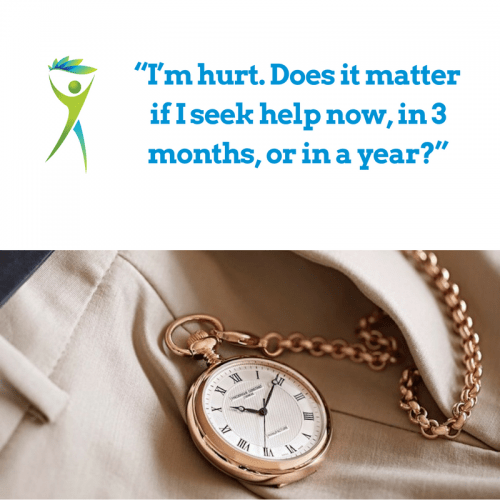
16 Jan “I’m hurt. Does it matter if I seek help now, in 3 months, or in a year?”
Last week, one of our Barefoot Rehab admins, Katie, was hanging out with a friend when she noticed this friend cringing when she picked up her 9 month-old daughter.
Katie asked “Are you hurt?”
“Yes, my shoulder has been hurting for two months. I’ve been seeing my chiro but it’s not helping. In addition to carrying my baby around, my son has been asking to be held too.”
Katie told me about her friend, her 9 month-old daughter, and 3 year-old son.
I told Katie:
You know what happens to 9 month-old human beings?
They get bigger.
The baby girl who weighs …
- 20 pounds at 12 months, will weigh …
- 25 pounds at 18 months,
- 28 pounds in 2 years, and
- 32 pounds in 3 years (Source).
According to the Reddit Thread Should I stop holding my 2.5 YO?, most parents still carry their kids around in their arms through the age of 3, when separation anxiety peaks.
Interestingly, many parents will hold their child as long as they are able (“able” meaning strong enough and pain-free to do so).

Think of it this way:
Two months of shoulder pain (that obviously isn’t going away on its own), when combined with increasing stress to the shoulder in the immediate future due to carrying a heavier and heavier “bowling ball” around (assuming at least until the age of 3) means GUARANTEED worse shoulder pain (and potential permanent damage).
So, does it matter if this loving mom seeks help for her shoulder now, in three months, in a year, or in 10 years?
Enter: Ben (Two Years of Heel Pain in Both Feet)
Ben, (name changed to protect confidentiality) age 50, entered our office with two years of heel pain in both feet.
The key point in Ben’s history is that he had two years of pain. I’ll come back to this point later.
During Ben’s exam, almost all of his tests were close to passing:
- Knee to Wall Test – 6″ (100%).
- Kneeling Heel to Butt Test – no space (100%) and symptom-free.
- Hamstring Stretch Test – 90 degrees (100%).
- Thigh to Chest Test – touching (100%).
- Lunge Stretch Test – 12″ (100%).
- Touch Your Toes Test – touch the ground (100%).
Ben had 5/10 pain, daily.
Anytime someone has more than slight pain (a 1 or 2 on the 10 point pain scale, where 10 is the worst pain ever) and very clean tests, it’s a red flag that there’s something more significant than adhesion (the most common cause of pain that is very easily removable by an expert) wrong.
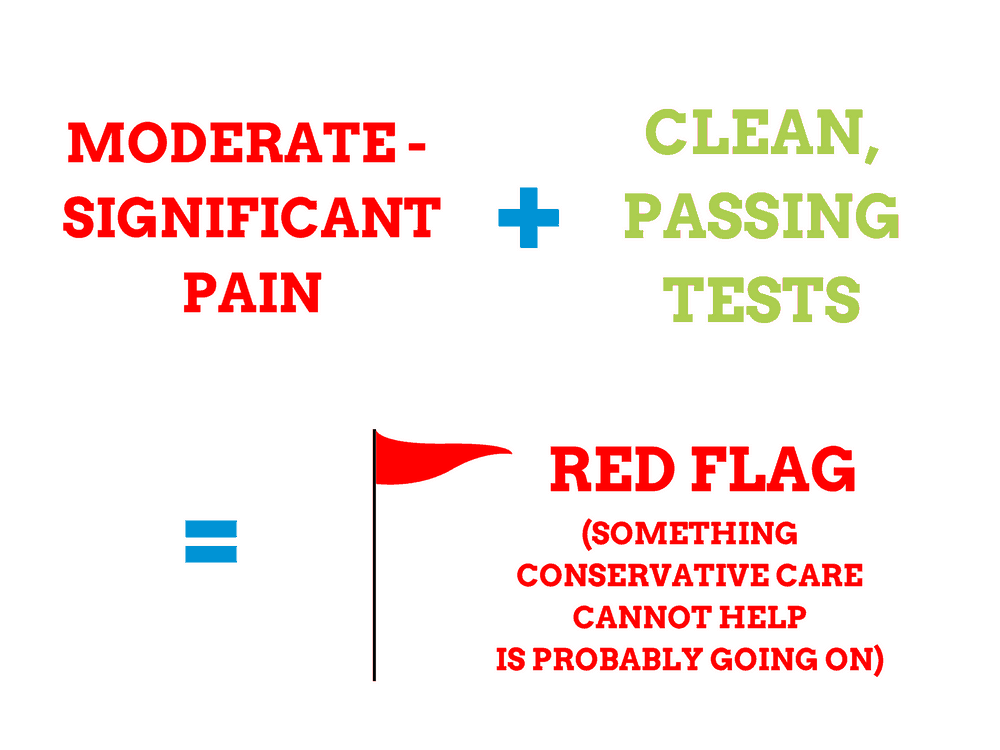
The only mildly positive tests were:
- One Leg Lockout – 65% of range on both feet
- The Pencil Test – 90%
- There was mild-moderate adhesion in the bottom of the foot, but it was extremely tender, even with gentle touching.
These findings were enough for me to attempt treatment, although I wasn’t expecting anything close to a home run.
After four treatments with no resolution (we guarantee to get some percentage relief in 5 visits or less, or we need to take different steps), we got an MRI on each of his feet.
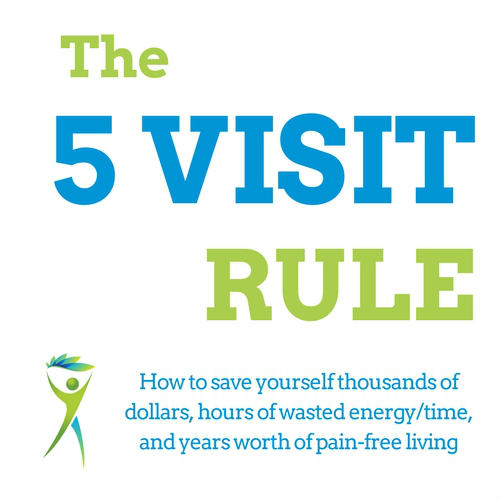
What you’ll notice below from his MRI reports is that Ben had at least 5 things wrong in both feet (HINT: That’s a lot!).
Many small to medium structural problems add up to make a BIG structural problem (that cannot be helped with conservative care).
MRI – Right Foot
- Mild thickening PF (this is the tissue responsible for causing his pain)
- Peroneus longus – longitudinal split tearing – above malleolus
- Small punctate interstitial tear under the malleolus
- Mild focal enlargement of PL tendon proximal to plantar turn
- Mild tenosynovitis
- Mild insertional tendinosis of tib posterior
- Focal fluid at FDL and FHL tendons
- Mild achilles tendinosis
- Deltoid ligament Grade 1 sprain
- Posterior subtalar joint effusion
- All of this for a guy who is not active – bad capacity, bad metabolism
MRI – Left Foot
- Moderate thickening PF (this is the tissue responsible for causing his pain)
- Mild insertional tendinosis achilles
- Mild insertional tendinosis of tib pos with focal tendon elargement
- Mild peronal longus tendinosis
- Peronal brevis is mildly falltened above malleolus
Whenever someone gets imaging at Barefoot Rehab, I personally look at the MRI images with the report so I can connect the dots between the person’s:
- Pain levels
- Tests (listed above)
- Response to treatment
- Image
I showed Ben the following pictures of his plantar fascia (the green circles are healthy areas of his plantar fascia, the red circle is where the plantar fascia is very thick and degenerated):
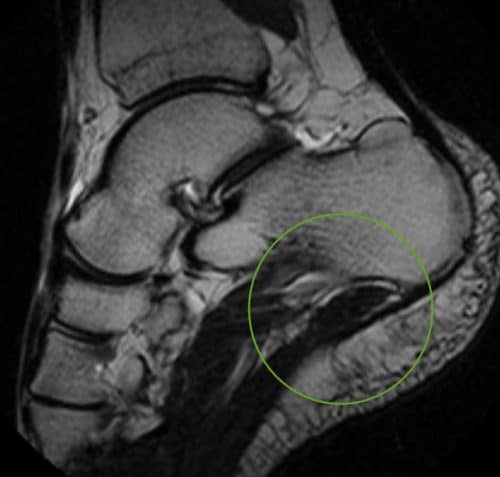
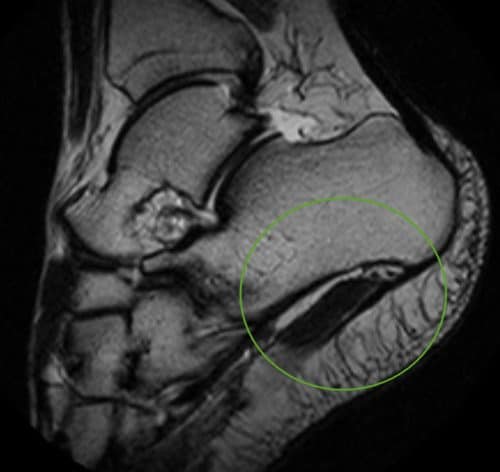
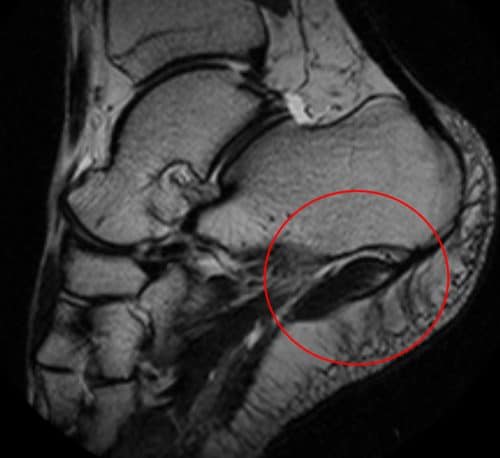
Remember, the image above with the red circle is only ONE of his many degenerated areas of tissue.
With all of this information put together, what did we do to continue Ben’s care?
I discharged him from care and referred him to an orthopedic doctor.
I gave him the Scope of Practice Speech:
Conservative musculoskeletal care (my scope of practice) cannot help you. There is no home run solution for you. For now, I’m referring you to get a surgical consult with a surgeon.
Then, the Persistence Speech:
If I knew of a home run solution for your feet, I would refer you there.
But, I don’t.
However, I find that the patients with issues who fail our care who do the best in the long-term don’t stop looking for solutions (they’re persistent).
My recommendation to you is to keep trying people and stuff, although I’m not optimistic about any of them.
That’s a tough pill to swallow, but it’s the reality of the situation.
Ben is the perfect example of a patient who should’ve been in our office after three months of pain and not two years.
The probability of success would have been much higher and we would have been able to catch the degeneration to his feet much sooner than when he presented.
A Small Window of Opportunity to Get Fixed
The earlier you get your problem looked at, the higher the probability you can be permanently and completely fixed.
We have a small window of opportunity to fix your problem. After the window closes, the opportunity ceases to exist.
With Ben, his problem became entirely degenerative, which is a permanent condition that can not be fixed, but can only be managed until one passes away.
How did it get there?
Last week, I had a patient ask how these chronic, not-fixable, problems develop. I got out a pencil and paper and drew a theoretical progression of pain problems over a 25 year period that we re-created below:
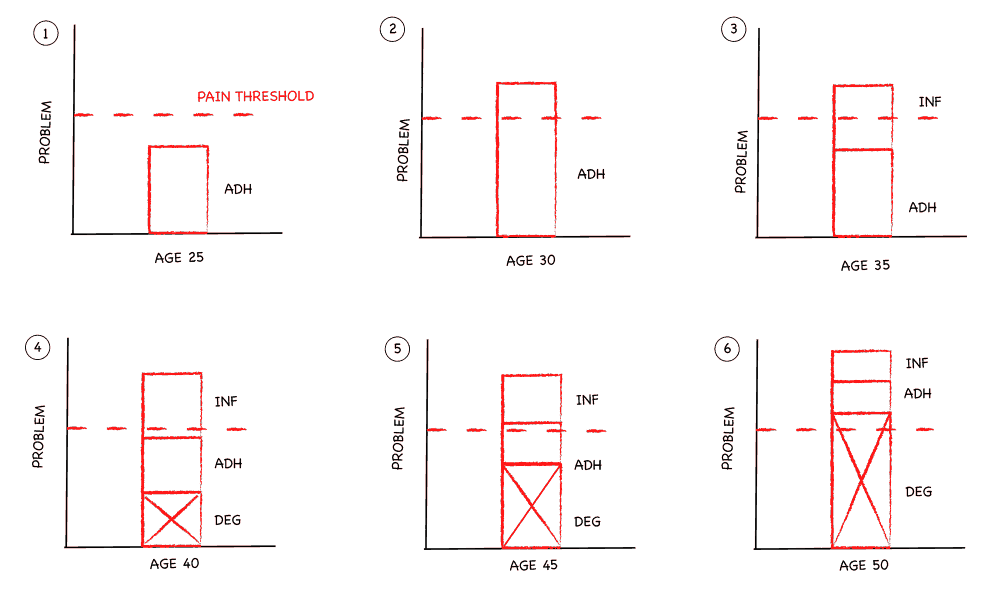
Kids and teenagers don’t usually complain of pain over any significant length of time.
Adolescents in their 20’s don’t either unless they’ve been seriously abusive to their bodies.
It’s usually people in their 30s through 50s who start to complain of ongoing, nagging aches and pains.
When you over use (load) your body more than it can handle (capacity), you spill out of some body part’s bucket. Your body will continue to operate pain-free for years, even decades.
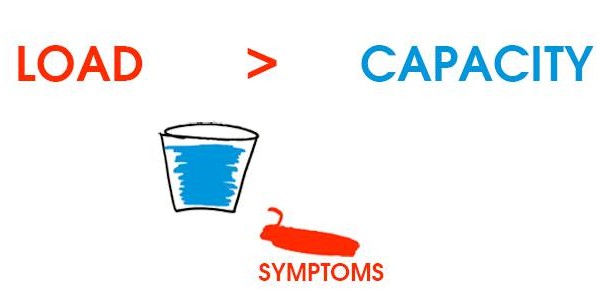
Just because you’re pain-free doesn’t mean that an iceberg isn’t getting bigger underneath the surface.
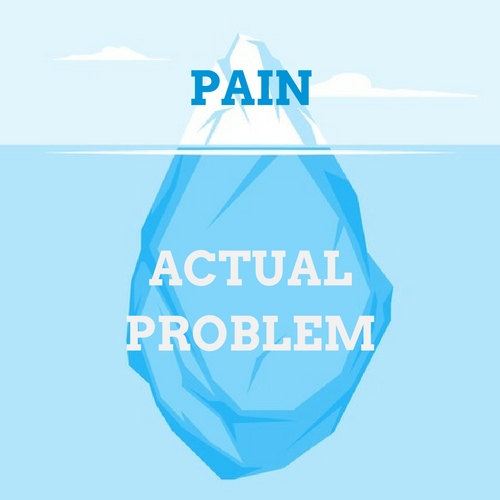
Overloading your bucket for a few weeks to months, without full recovery, leads to your body laying down the most common problem causing pain in the body, adhesion (ADH).
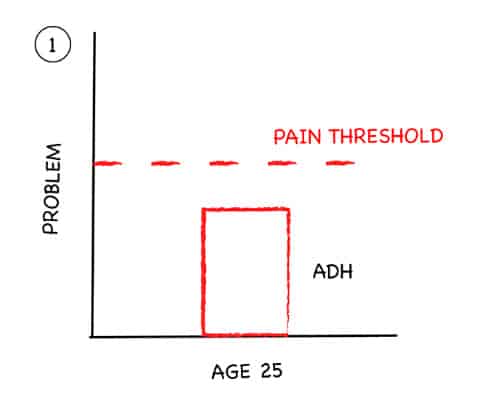
Notice, it’s under the “Pain Threshold”. Even though you do have a problem, you don’t feel it because it’s not big enough yet.
For most of us, this starts to happen in our mid-20s.
Because you don’t feel pain, you keep doing what you’re doing.
The adhesion gets thicker, with your under the water iceberg slowly approaching the surface, until your problem passes your “Pain Threshold” and you start to feel pain. This pain is easily manageable with chiropractic, physical therapy, foam rolling, or massage.
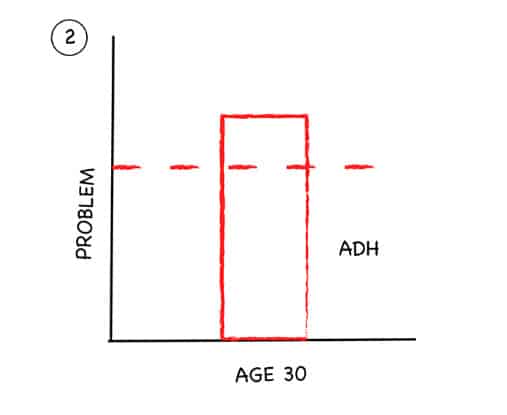
As you continue managing your pain instead of fixing the cause of your problem, your body becomes inflamed (INF) as observed by MRI. Relatively, your adhesion (ADH) is now smaller when compared with the new presence of the inflammation (INF).
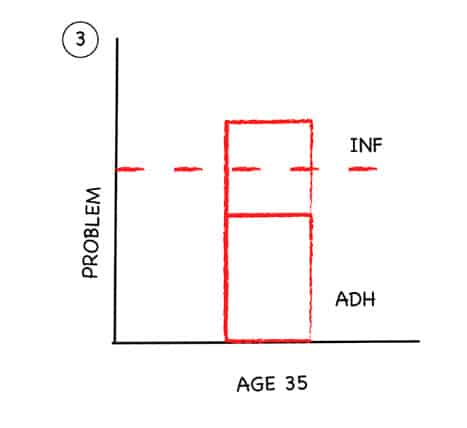
The inflammation (INF) could be a golfer’s elbow or tennis elbow (tendonitis), an acutely inflamed low back or neck disc, or plantar fasciitis (heel pain).
Do any treatment that doesn’t remove the adhesion (ADH) and while the pain may go away, it’s only the inflammation (INF) block that temporarily disappears. When you continue using your body, the adhesion (ADH) is still there and will continue to put stress on the body part that became inflamed (INF). Eventually, this inflammation (INF) continues to put stress on bones, discs, and cartilage and becomes permanent (the “X” indicates that the block cannot be removed) damage or degeneration (DEG).
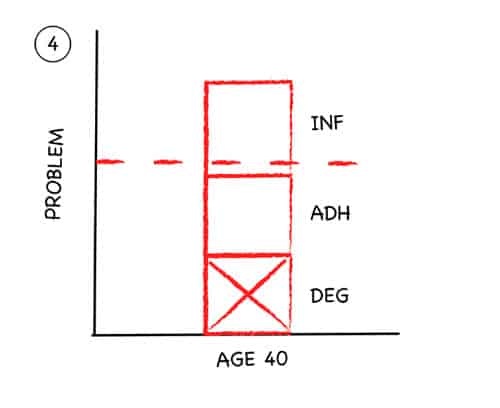
Notice, relatively speaking, this individual now have three different problems that are about equal size. Removing the adhesion (ADH) with Manual Adhesion release and the inflammatory block (INF) by removing the adhesion (ADH) and resting can make both of those blocks disappear.
The presence of the degenerative block (DEG) with the “X” through it means you now have a permanent problem that cannot be fixed, it can only be managed over the long term.
Continue to neglect address the primary problems and the degenerative block (DEG) is sure to get only bigger relative to your other problems.
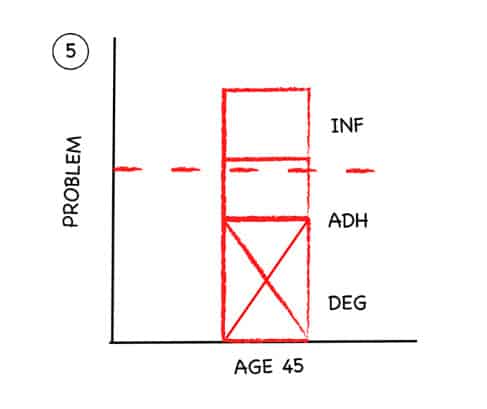
Notice, the adhesion block (ADH) is even smaller now.
When it gets too small, getting rid of the adhesion like I did with Ben doesn’t make enough of an impact to permanently affect someone’s pain.
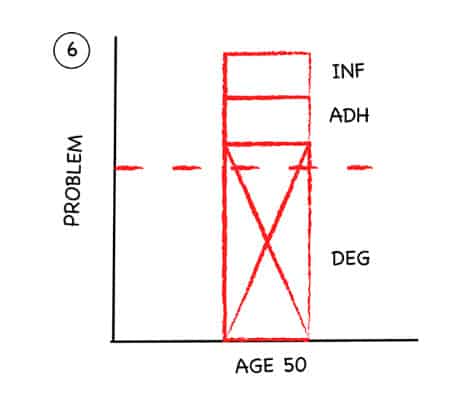
Thus, the window of opportunity to fix him is gone and at 50 years of age, I pray that Ben finds an answer for his pain.
Do You Want Ignorance or Truth?
Most people who have reoccurring pain choose ignorance.
They may have found a treatment that works for a little while and they resort to that.
Or, not realizing there are any potential better solutions, they choose to ignore the pain even exists.
Truth #1 is that at Barefoot Rehab, we don’t fix everyone (i.e. Ben).
Truth #2 is that at Barefoot Rehab, we specialize in offering the highest probability of relief to people who have had at least two months of pain and who have have seen at least 3-5 other doctors or healthcare providers.
We offer #2 to people who suffer by diagnosing people honestly and completely and by being the only practice in North Jersey certified to find and fix the most common problem causing pain in the body, adhesion.
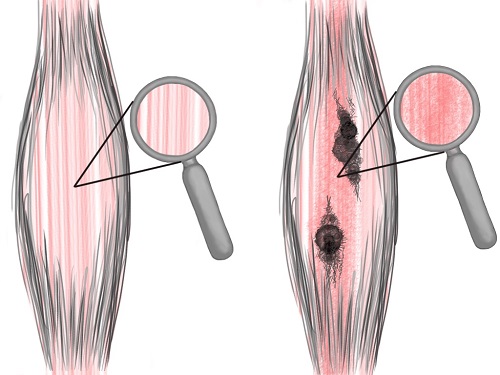
Before reading this post, you may have thought ignorance was your only choice.
Now, you can choose ignorance or truth.
Once you become aware to that choice, time becomes quite precious.
I wish I started care later.
~ No one ever
Choose Wisely
Your best opportunity to get fixed is as soon as you realize the pain is:
- reoccurring (has occurred more than once in the past) or
- not being relieved on its own or with whatever standard intervention you have been choosing.
Given your opportunity, it suits you to choose the most excellent, expert care you can find.
At Barefoot Rehab, our sweet spot for fixing people in pain happens to be the 30-50 year old range.
Why?
Younger than 30 implies that:
- the pain, when present, usually goes away quickly and on its own.
- if treatment is needed, more conventional treatments like physical therapy, chiropractic, massage, and cortisone help the pain go away.
- if the pain lasts more than a few weeks to months, it’s usually a red flag situation.
Older than 50 implies that:
- your pain is more of a degenerative problem and less of an adhesion problem.
This observation doesn’t mean we don’t fix people younger than 30 or older than 50. But our batting average goes down outside of this 20-year window of opportunity.
Choose wisely.
In honest reality, the time is now to see a musculoskeletal expert.
FYI – After a healthy dose of perspective from Katie, her friend came in to get fixed this week. She chose truth. : )
I’m curious, what has stopped you in the past from getting care immediately when you know you need it? I’ve found that the #1 reason people don’t pursue care as soon as they know they need it as this. They don’t trust that the doctor will tell them the truth and they don’t think they can be fixed. That’s why we have the 5 Visit Rule in our practice. Comment below if you have a different reason.


No Comments